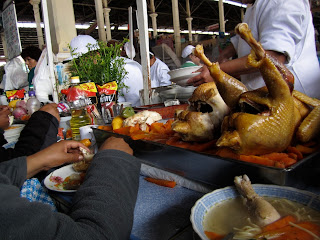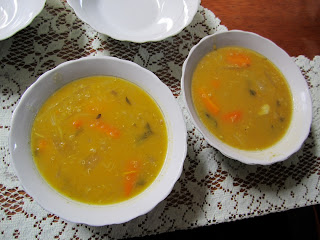 My garden is out of control.
My garden is out of control.New Hampshire gardens are like a roller coaster. They creep along for all of June and most of July and then you wake up one morning and everything is ready and you have no place-in your body, fridge, cellar, or freezer-to store it. So what do you do? Collect it and can it.
If you don't already own the food processing bible (not like food processor, but as in extending its shelf life), Putting Food By**, by three extremely intelligent old biddies, Janet, Ruth, and Beatrice... go buy it. I mean at this very moment. Any version is good. Mine is taped together and is a 70's edition.
Anyways, this book is a self-help book for the bumper-crop gardener. Everything is at your fingertips: from canning to freezing to drying to root cellar storage, all complete with scientific explanations. My favorites are the bread and butter pickles, dilly beans, pickled carrots, and homemade salsa.
Soft pickles kinda blow. They are almost always slimy and dissolved under the tongue. These three pickle suggestions will be crunchy. Promise. And most importantly, pickling really isn't hard. It feels more like a craft project with delicious benefits. It's a great project to do with friends.
**for these recipes, you really should read about canning in Putting Food By. It's explains in detail why canning is both a pain in the ass, the reasons for it being so, and why its worth it.
Pickled Carrots
makes approximately 6 pints
4 pounds of fresh, washed, preferably young carrots, quartered lengthwise (or beans if doing dillies)
6 cloves garlic
 3 jalapeños or other hot peper of your choice, quartered length-wise
3 jalapeños or other hot peper of your choice, quartered length-wise6 teaspoons non-iodized salt (pickling, kosher, or sea)
6 tablespoons sugar
2 cups water
2 cups white vinegar
optional additions:
coriander seeds
peppercorns
mustard seeds
cumin seeds
raw yellow onion
flowers from dill plants
Set up a pot of boiling water that can fit all six jars standing up. Put a steamer basket or use a canning pot. Sterilize the jars with boiling water for 15 minutes.
Bring the vinegar and water to a boil in a different pot over medium heat.
Wash and scrub the carrots. If they are young, they have thin skin and do not need to be peeled. If they are big conventional-sized ones they should be peeled or the final product will taste a little woody-dirty.
cut one carrot the the exact length of the canning jar, minus 3/4 of an inch. Use this carrot to trim all the carrots the the same length. Some you will be able to get two lengths from. Quarter these the long way. On a clean towel, lay the sterilized jars flat on their sides and begin stacking the carrots in the jars. Include one quarter of pepper in each jar. Once they are as full as they can be on their side, turn them right side up and try to fit in a few more carrot sticks. Really wedge them in there!

Next, line up the jars. In each jar put 1 teaspoon of salt and 1 tablespoon of sugar in each jar. Poke one garlic clove in each jar as well. add a quarter teaspoon of any of the spices listed above, or a dill flower, or a sliver of onion. Top each jar with the boiling vinegar mixture to 3/4" from the top. Tap the jar gently on the table top. Wipe the rims with a clean paper towel. Top with clean *NEW* mason jar lids (the bands can be used but the lids always have to be new) and bands, and do not fully tighten... they need a little room to expand!
 Then, place them in the canning pot and lower them down (they will displace some water so get ready) and be sure the tops of the jars are covered with water (even just barely). Process in boiling water for 15 minutes (don't start timing til the water is actually boiling). After 15 minutes, removed the jars carefully and let them cool on the counter.
Then, place them in the canning pot and lower them down (they will displace some water so get ready) and be sure the tops of the jars are covered with water (even just barely). Process in boiling water for 15 minutes (don't start timing til the water is actually boiling). After 15 minutes, removed the jars carefully and let them cool on the counter.Variations on the carrots include beets, dilly beans, mixed vegetables (cauliflower, radish, fennel, zucchini), and pickled beets. For dilly beans, be sure to include a dill flower/head. Stack them and process them the same as carrots. When they are finished, they should look something like this:

If you love sweet and crunchy bread and butter chips, this following recipe works like a charm. When buying pickling cukes, buy the smallest ones you can find. They always lend to crunchier results.
Bread and Butter Pickles
makes approximately 6 pints
6 pounds of small pickling cucumbers, 1/4 inch slices
1 large onion, sliced
6 cloves of garlic, sliced
3 cups sugar
4 cups white vinegar
2 tablespoons mustard seed
1 teaspoon turmeric
12 peppercorns
chilis (fresh or dried, to taste)
1/2 non-iodized salt
2 trays ice cubes
Set up a canning pot that fits all jars. sterilized them in boiling water for 15 minutes.
In a large bowl combine cukes, onions, salt, and ice cubes. Toss everything together and cover with a towel. Let rest for 3 hours.
After 3 hours, rinse the cukes thoroughly in cold water, changing the water a few times. lay out on a towel to dry.
Combine the rest of the ingredients into a pot and heat to boiling over medium heat. When boiling, add the cukes and onions to the brine, stir, and return to a boil and cook 5 minutes *BOILING*. In the mean time, line up your sterilized jars and *NEW* lids. Using a canning funnel (this keeps the rims clean, if you don't have one you'll have to wipe with a damp paper towel), fill the jars with the cukes, pulling with a ladle from the bottom of the pot where the spices are sitting. Use a clean spoon or butter knife to pack them in, 3/4" from the top, topped with brine. Wipe the rims, tap the jar gently on the table to remove bubbles, and top with lids and bands. Again, don't fully tighten the lids. Load into the canning pot, covered in water, and process for 10 minutes, *BOILING*.
They should look like this:
 Homemade Salsa
Homemade Salsamakes approximately 4-6 pints

8 large garden tomatoes
2 onions
6 cloves garlic
6 assorted peppers (jalapeños, anaheim, poblano, the more variety the better)
a bunch of cilantro
salt
cider vinegar
lime, optional
Sterilize 4-6 jars in a boiling water bath for 15 minutes.
You can make this mix into a smokey salsa or a fresh one. For smokey, quickly grill the peppers, onions, and garlic over a wood fire, in their entirety. That's right, leave the skin on and keep 'em whole. This imparts a bit of smoke flavor but keeps the crispness of fresh veggies. Not more than five minutes.
Cut the tomatoes in half, horizontally, and gently squeeze the seeds out. Don't be picky, not a big deal. What falls out falls out. Rough chop the tomatoes to your liking. Peel the onion and garlic, seed or deseed the chilis.... up to you. Take everything but the tomatoes and grind in the food processor til finely chopped. Put this mix and the tomatoes in a bowl. Figure out how many quarts you have by measuring this mixture as you transfer it to a large pot. For each quart, add 1 teaspoon salt, and two tablespoons cider vinegar to the pot of salsa. Add the lime (really, however much you want) at this point, too. Bring the mixture to a boil.
Once boiled, fill the jars, again, ladling from the bottom. fill within 3/4" from the top. Just like before, clean lids, bands, not too tight. Process for 20 minutes in *BOILING* water bath.
For all canned items, plan to leave them alone for at least a week. It develops better flavor. They should keep for up to a year. There is nothing better than cracking one of these jars open in the dead of winter. Delicious!
HAPPY CANNING!











































